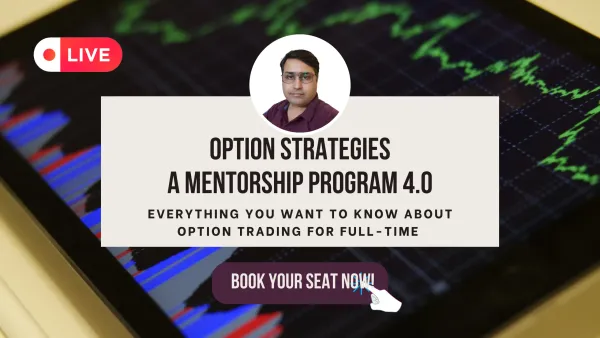How to Profit from Being a Contrarian in the Stock Market with Option Strategies
Learn how to be a contrarian trader in the stock market using option strategies. Discover how to analyze the market sentiment, find the best stocks and indices, choose the right option contracts, manage your risk and reward, and optimize your entry and exit points.

“Do you know what investing for the long run but listening to market news everyday is like? It’s like a man walking up a big hill with a yo-yo and keeping his eyes fixed on the yo-yo instead of the hill.” - Alan Abelson, former editor of Barron’s.
If you’re an option trader, you know how tempting it can be to follow the market news and trends. You might think that by doing so, you’re staying on top of the game and making smart decisions.
But what if I told you that there’s a better way to trade options?
A way that can help you make more money, with less stress, and more fun?
A way that goes against the crowd and the conventional wisdom?
A way that’s called contrarian trading.
Contrarian trading is a style of investing that goes against the prevailing market trends. It involves buying low and selling high, or vice versa, when most people are doing the opposite.
Contrarian traders believe that the market is often wrong, and that by going against the herd, they can exploit the market inefficiencies and profit from the mispricing of assets.
Contrarian trading is not easy, but it can be very rewarding. In this blog post, I’m going to show you how to profit from being a contrarian in the stock market, using option strategies.
But before I do that, let me tell you a story.
A story of how I made a fortune by going against the crowd.
How I made 900% profit in two months by being a contrarian
It was back in 2019, when the Indian stock market was in a bear market. The Nifty 50 index had dropped by over 20% from its peak, and everyone was pessimistic about the future.
Everyone, except me.
I had a different view.
I saw that the market was undervalued, oversold, and underappreciated. I saw that the fundamentals were strong, the earnings were improving, and the opportunities were abundant.
I saw that the market was ready for a rebound.
So I did what any contrarian would do.
I bought call options.
Call options are contracts that give you the right to buy a stock or an index at a specified price within a specified time period. They are a way of betting that the market will go up.
I bought call options on the Nifty 50 index, with a strike price of 11,000 and an expiry date of December 2019.
I paid a premium of Rs. 50 per option, and I bought 1000 options.
That means I invested Rs. 50,000 in total.
My plan was simple.
If the market went up by 10% or more, I would make a huge profit.
If the market went down or stayed flat, I would lose my premium.
I was willing to take that risk.
I was confident that I was right and the market was wrong.
And I was right.
In November 2019, the market rallied.
The Nifty 50 index surged by over 15%, from 10,000 to above 11,500.
The reason was a combination of factors, such as corporate tax cuts, easing of trade tensions, and positive economic data.
The market was surprised, and optimism returned.
But I was prepared.
I was smiling.
I was making money.
My call options were now worth Rs. 500 each, and I sold them for a total of Rs. 5 lakhs.
That means I made a profit of Rs. 4.5 lakhs, or 900%, in just two months.
That was one of the best trades of my life.
And it was all thanks to contrarian trading.

How to be a contrarian trader in the stock market
Do you want to learn how to do the same?
Do you want to learn how to spot the market trends, identify the turning points, and execute the trades that can make you rich?
If yes, then here are some tips on how to be a contrarian trader in the stock market, using option strategies.
1. Analyze the market sentiment and psychology
The first step to being a contrarian trader is to analyze the market sentiment and psychology. You want to know what the majority of the market participants are thinking, feeling, and doing.
You can use various tools and sources to gauge the market sentiment and psychology, such as:
- Technical indicators, such as the Relative Strength Index (RSI), the Moving Average Convergence Divergence (MACD), and the Bollinger Bands. These indicators can help you measure the momentum, trend, and volatility of the market, and identify the overbought and oversold conditions.
- News and media, such as newspapers, magazines, blogs, podcasts, and social media. These sources can help you understand the current events, opinions, and expectations of the market, and identify the hype and fear factors.
- Surveys and polls, such as the Investor Sentiment Survey by the Association of Individual Investors (AAII), the Fear and Greed Index by CNN Business, and the Volatility Index (VIX) by the Chicago Board Options Exchange (CBOE). These surveys and polls can help you quantify the level of optimism and pessimism of the market, and identify the extremes of greed and fear.
By analyzing the market sentiment and psychology, you can find out if the market is bullish or bearish, and if it’s rational or emotional.

You can then use this information to formulate your contrarian strategy.
2. Find the best stocks and indices to trade
The next step to being a contrarian trader is to find the best stocks and indices to trade. You want to find the assets that are most affected by the market sentiment and psychology, and that have the most potential to move in the opposite direction.
You can use various tools and methods to find the best stocks and indices to trade, such as:
- Fundamental analysis, such as the price-to-earnings ratio (P/E), the price-to-book ratio (P/B), the dividend yield, and the earnings growth. These metrics can help you measure the value, quality, and profitability of a stock or an index, and identify the undervalued and overvalued assets.
- Sector rotation, such as the sector performance, the sector correlation, and the sector rotation model. These methods can help you measure the relative strength and weakness of different sectors of the market, and identify the leading and lagging sectors.
- Relative strength, such as the relative strength index (RSI), the relative strength line (RSL), and the relative strength rank (RSR). These indicators can help you measure the performance of a stock or an index compared to the market or another asset, and identify the outperforming and underperforming assets.
By finding the best stocks and indices to trade, you can narrow down your options and focus on the assets that have the most contrarian opportunities.

3. Choose the right option contracts
The third step to being a contrarian trader is to choose the right option contracts. You want to choose the option contracts that match your contrarian view, and that have the best risk-reward ratio.
You can use various factors to choose the right option contracts, such as:
- Volatility, such as the implied volatility (IV), the historical volatility (HV), and the volatility skew. These factors can help you measure the expected price movement of a stock or an index, and the demand and supply of the option contracts, and identify the cheap and expensive options.
- Liquidity, such as the bid-ask spread, the open interest, and the volume. These factors can help you measure the ease of buying and selling the option contracts, and the market activity and interest, and identify the liquid and illiquid options.
- Time decay, such as the theta, the time value, and the expiration date. These factors can help you measure the rate of decline of the option value due to the passage of time, and the remaining life of the option contracts, and identify the fast and slow decaying options.
By choosing the right option contracts, you can optimize your contrarian trades and maximize your profits.
4. Manage your risk and reward
The fourth step to being a contrarian trader is to manage your risk and reward. You want to manage your risk and reward in a way that suits your contrarian style, and that protects your capital and profits.
You can use various tools and techniques to manage your risk and reward, such as:
- Stop loss, such as the percentage stop, the volatility stop, and the chart stop. These tools can help you set a predetermined exit point for your contrarian trades, and limit your losses in case the market moves against you.
- Trailing stop, such as the moving average trailing stop, the parabolic SAR trailing stop, and the ATR trailing stop. These tools can help you adjust your exit point for your contrarian trades, and lock in your profits as the market moves in your favor.
- Profit target, such as the risk-reward ratio, the Fibonacci retracement, and the pivot point. These tools can help you set a predetermined exit point for your contrarian trades, and take your profits when the market reaches your desired level.
By managing your risk and reward, you can control your contrarian trades and increase your chances of success.

5. Optimize your entry and exit points
The fifth step to being a contrarian trader is to optimize your entry and exit points. You want to optimize your entry and exit points in a way that enhances your contrarian strategy, and that improves your timing and accuracy.
You can use various tools and methods to optimize your entry and exit points, such as:
- Candlestick patterns, such as the hammer, the shooting star, and the doji. These tools can help you identify the reversal and continuation signals of the market, and enter and exit your contrarian trades at the optimal moments.
- Trend lines, such as the uptrend line, the downtrend line, and the horizontal line. These tools can help you draw the support and resistance levels of the market, and enter and exit your contrarian trades when the market breaks or bounces from these levels.
- Chart patterns, such as the head and shoulders, the double top and bottom, and the triangle. These tools can help you recognize the formation and completion of the market trends, and enter and exit your contrarian trades when the market confirms or invalidates these patterns.
By optimizing your entry and exit points, you can fine-tune your contrarian trades and enhance your performance.
How to join Option Strategies: A Mentorship Program for contrarian traders
If you’ve read this far, you must be interested in learning more about contrarian trading and how to apply it to the stock market using option strategies.
If that’s the case, then I have a special offer for you.
I’ve "Option Strategies: A Mentorship Program" for contrarian traders.
In this mentorship program, you will learn everything I’ve shared with you in this blog post, and much more.
You will learn how to:
- Analyze the market sentiment and psychology using technical indicators, news, and social media.
- Find the best stocks and indices to trade using fundamental analysis, sector rotation, and relative strength.
- basics of option trading like option pricing, intrinsic value, time value, greeks, implied volatility and much more.
- Choose the right option contracts based on volatility, liquidity, and time decay.
- Manage your risk and reward using stop loss, trailing stop, and profit target.
- Optimize your entry and exit points using candlestick patterns, support and resistance, and trend lines.
- Diversify your portfolio and hedge your positions using different option strategies, such as straddles, strangles, spreads, and collars.
And much more.
This mentorship program is suitable for beginners as well as experienced traders.
You don’t need any prior knowledge or experience in options trading.
You just need a laptop, an internet connection, and a willingness to learn.
The mentorship will be available with recorded videos plus it gives you a chance to learn through one to one sessions with me.
The mentorship program fee is Rs. 50,000, but if you register before December 5th, you can get a 70% discount.
That means you can join the mentorship program for only Rs. 15,000.
That’s a steal, considering the value you will get from this mentorship program.
You will learn the skills and strategies that can help you make consistent profits in the stock market, regardless of the market conditions.
You will also get access to a private Facebook group, where you can interact with me and other participants, ask questions, share ideas, and get feedback.
You will also get a certificate of completion, and a lifetime access to the workshop recordings and materials.
But hurry, because the seats are limited.
Only 10 people can join this mentorship program for December batch, and they are filling up fast.
So don’t miss this opportunity.
Click the link below and register for the mentorship program today.
Trust me, this will be the best investment you will ever make.
You will thank me later.
Remember, the market is always changing, and so should you.
Don’t follow the crowd, follow your own path.
Be a contrarian, and be a winner.
I hope to see you in the mentorship program.
Happy trading,
Your learning partner.






